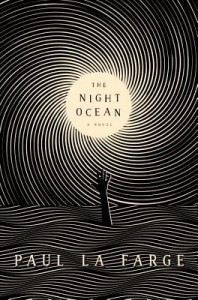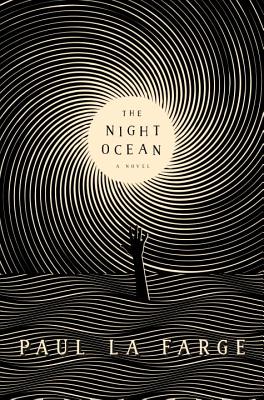 The Night Ocean
The Night Ocean
by Paul LaFarge
Penguin Press. 389 pages, $27.
HORROR WRITER H. P. Lovecraft (1890–1937) often used the word “queer” in his stories. Old architecture, tomes of forbidden knowledge, and unholy religious rites were all described as queer. From the context, a reader assumes he used it as an archaic synonym for “strange.”
Lovecraft’s own life might be described as queer, in both that older meaning and possibly the newer one. Although he was born into a wealthy Rhode Island family, his biography actually reads like a horror story. When he was eight, his father died in a psychiatric hospital where he had been admitted for psychosis possibly brought on by syphilis. Lovecraft’s mother also died there many years later, but not before convincing the young Lovecraft of his own hideousness and poor state of health. Lovecraft had his own nervous breakdown at the tender age of eighteen, which prevented him from completing high school and dashed his hopes of attending Brown University. When his grandfather died, he fell into poverty.
Perhaps because of this Gothic childhood, Lovecraft became a horror writer, publishing dozens of stories in pulp magazines like Weird Tales. His narratives usually feature WASPy, bookish men who are destroyed after encountering alien abominations, blasphemous secrets, and sinister cults. Moderately popular while alive, Lovecraft’s reputation grew posthumously, and he is now considered one of the world’s great horror writers.
In recent years scholars have focused on Lovecraft’s racism as well as his attitudes toward sex. The horrors in his tales are often sexual in origin. In “Facts Concerning the Late Arthur Jermyn and His Family,” a British nobleman learns his great-grandmother was a gorilla, while in “The Unnamable” the monstrous offspring of a Puritan and a cow lurks in an old New England house. Fishermen mate with aquatic monsters in “The Shadow Over Innsmouth,” and a backwoods wizard pimps his daughter out to an extra-dimensional deity in “The Dunwich Horror.” One of her sons by the deity is a huge invisible monster. The other looks human from the waist up but has writhing tentacles instead of genitals. When he dies, he melts into a puddle of thick white fluid reminiscent of semen.
Despite these lurid stories, very little is known of Lovecraft’s own sex life. It’s possible there is little to know. While vocal in his anti-Semitism, he married Sonia Greene, a Jewish immigrant involved with the amateur press movement. Their marriage lasted two years, but they only lived together for one. Greene claimed Lovecraft was an adequate lover but little else, and that she always had to take the initiative. She is his only known lover.
He may simply have been uninterested in sexual intercourse, but some writers have speculated that Lovecraft was secretly gay. Although he openly expressed anti-gay sentiments, some of his stories do support a queer reading. For example, the male narrator of “The Lurking Fear” hires two musclemen to accompany him on a trip to a haunted mansion. Upon arriving, they all sleep in the same bed. An all-male mob of naked sailors give themselves over to “orgiastic license” while worshiping an alien squid-god in “The Call of Cthulhu.” And the ghost of another sailor, handsome and dark-skinned, lures the crew of a German U-boat to watery doom in “The Temple.”
More tellingly, in “Hypnos,” the male narrator finds a beautiful man passed out in a train station. He is like a “faun’s statue out of antique Hellas,” and the narrator befriends him instantly and brings him home, asking him to be “my teacher and leader in unfathomed mysteries.” Lovecraft dedicated this story to his good friend Samuel Loveman, a minor gay poet. Through him Lovecraft met other gay writers, including Hart Crane. Lovecraft disapproved of Crane’s “dissipated habits” but also remarked on his good looks.
Toward the end of his life Lovecraft befriended a gay teenager named Robert Barlow, and their relationship is the subject of The Night Ocean, Paul LaFarge’s weird and wonderful new novel. The facts of their relationship are these. Barlow was a fan of Lovecraft’s stories and invited the author to come visit him in Florida. Lovecraft agreed, staying with Barlow and his mother for seven weeks in 1934. He was 43 at the time; Barlow was sixteen. Lovecraft returned for a second, longer visit in 1935, and Barlow visited him in Providence the next year. They collaborated on one short story, “The Night Ocean.”
Before Lovecraft died, he named Barlow as his literary executor, a move that angered his older, more established literary friends, who hounded Barlow out of the horror fiction community. He eventually became a prominent anthropologist in Mexico, teaching in Mexico City until 1951, when he committed suicide after a student threatened to expose him as a homosexual.
Barlow’s homosexuality is well-documented. There is no firm evidence that Lovecraft was gay, but LaFarge spins the facts of their lives into an entertaining and sometimes unnerving meditation on fiction, lies, and the stories we tell ourselves to survive. The Night Ocean follows New York psychologist Marina Willett as she tries to piece together why her husband, a writer named Charlie, has drowned himself in a lake. Charlie achieved success after writing about The Erotonomicon, a secret diary recording Lovecraft’s sexual encounters with underage boys, including Barlow. The diary had been thought a hoax, but Charlie discovered evidence that not only was it authentic but also that Barlow faked his own death. When a scandal destroyed Charlie’s reputation, he spiraled into a suicidal depression.
Or so it seems. But Marina receives hints that Charlie is still alive and starts investigating Barlow, The Erotonomicon, and her husband’s own secret activities. She soon finds herself tangled in a decades-old web of lies and half-truths that span the globe from Hungary to Mexico. At its center sits an elderly Canadian recluse named L. C. Spinks, who may not be who he claims.
Like his characters, LaFarge mixes fact and fiction to potent effect. William S. Burroughs, Roy Cohn, and real-life Lovecraft scholar S. T. Joshi all make appearances, and LaFarge devotes a sizable portion of the book to recreating Barlow’s life in Mexico. Famous science fiction writers like Isaac Asimov and Ursula K. LeGuin also have roles to play, as do historical events like the Holocaust. At times it’s hard to determine what is real and what is purely LaFarge’s creation. Even his characters get confused; at one point Charlie and Marina speculate that they might be enacting Lovecraft’s “The Case of Charles Dexter Ward,” whose villainous wizard kills a researcher named Charles before being defeated by a doctor named Marinus Willett.
Marina’s name references not only Lovecraft’s hero, but also the heroine of Shakespeare’s play Pericles, whose mother is resurrected after dying at sea. Marina’s hope for a happy ending guides her and the reader through LaFarge’s narrative labyrinth, which is filled with suicide, pathological liars, war, drug abuse, racism, and homophobia. Lovecraft’s tentacled monsters seem quaint when compared to the modern horrors of The Night Ocean, but readers will need to determine for themselves if LaFarge’s book is ultimately hopeful or horrific.
Peter Muise, who writes about New England folklore, is the author of Legends and Lore of the North Shore (2014).






